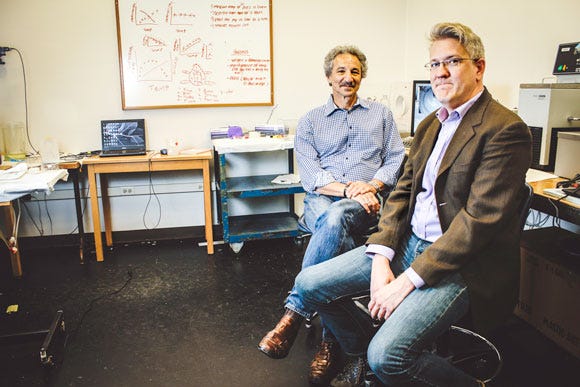IU Heats Up Research on Fever and Autism
 IU researchers Jeffrey Alberts (left) and Christopher Harshaw are leading the study.
IU researchers Jeffrey Alberts (left) and Christopher Harshaw are leading the study.
Subscriber Benefit
As a subscriber you can listen to articles at work, in the car, or while you work out. Subscribe NowIt’s called “the fever effect”—and some families impacted by autism say they’re relieved it’s finally getting the attention it deserves. It refers to anecdotal evidence that when some autistic patients get a fever, the disorder’s social symptoms seemingly disappear. The moment Kristie McAllister experienced the fever effect in one of her sons is burned in her memory: “it felt like we had seen a ghost,” she says. And she feels like that’s about as seriously as the research community has taken it—like an apparition—until she saw, with great relief, that an Indiana University researcher will use a nearly $1 million grant to focus on the phenomenon.
McAllister’s sons are now grown, but her experience with the fever effect was so profound, she recalls it clearly today, some 20 years later. Her oldest son, who has autism, was up in the middle of the night with a severe cold and running a fever. He was three years old, and considered “nonverbal”; McAllister says his communication was limited to only making the sound “ch” for Cheerios.
“Suddenly, he looked at us and said, ‘can you pass me a Kleenex, please? My nose is running.’ My husband and I just stared at each other with our jaws dropped,” says McAllister. “After the shock disappeared, my husband and I kept saying to each other over and over for days, ‘you heard that, right?’”
Her younger son, who is autistic as well, also showed improvements with a fever: “for years, his teaching assistant would consistently know when he was about to get sick, because he would communicate more at school when a fever was beginning,” says McAllister. She recalls they mentioned the incident to their doctor and specialist, who both didn’t know what to say, “so we never shared our experience with this phenomenon again.”
IU Psychological and Brain Sciences Assistant Research Scientist Dr. Chris Harshaw says these anecdotes have been documented since the 1970s, but have never been scientifically evaluated. He plans to start that process with a recent $900,000 National Institutes of Health grant that will, for the first time, dig into the basic science of potential connections between fever and the relief of autism’s social symptoms.
“There are some cases that have been written up where the parents were even convinced the child was cured, because they were so normal, so it seems almost miraculous to parents when it happens,” says Harshaw. “The purpose of this grant is to figure out how problems with body temperature regulation can affect behavior, especially social behavior.”
Harshaw’s study will focus on an animal model that will observe social behavior and issues with the thermoregulatory process, which is the regulation of body temperature. His lab will also examine oxytocin, known as the “social/love hormone,” that seems to produce positive social effects. Harshaw cautions the three-year grant will only “scratch the surface,” but serve as a stepping stone to more detailed studies.
“I think the most likely mechanism for some of these anecdotes of the fever effect is simply through the avenue that, when [an autistic person] has a fever, the brain is running a bit hotter than it would normally, and that has some effects on cognition,” says Harshaw. “That’s where future grants would go; more specifically about brain temperature. It’s a frustratingly slow process.”
Harshaw believes his study is also significant because it represents a new approach to autism research. He says the last four decades of neuroscience and psychiatry studies related to the disorder have focused on the brain and genetics, “which haven’t given researchers much leverage toward understanding the disorder.”
“There’s been such a focus on the brain, that other biological and physiological parameters—like temperature—have basically been ignored,” says Harshaw. “If it turns out to be something where there is a meaningful connection with autistic people tending to have brains that are running a bit cool, then it’s almost like an engineering problem at that point; it’s just a matter of time before people figure out therapies that will at least help.”
McAllister’s sons are now grown and more communicative, and therefore, have less profound effects from fever. But she says the study validates her experience with the phenomenon and makes her feel relief, “like someone out there is now listening.”
“[Witnessing the fever effect] was surreal, shocking and exhilarating all at once. When it was over, it made me feel a sense of loss,” says McAllister. “Wouldn’t it be great if, someday, they could duplicate the fever effect somehow and allow nonverbal individuals with autism to communicate easily? That’s a dream for me. It’d be better than winning the lottery.”
